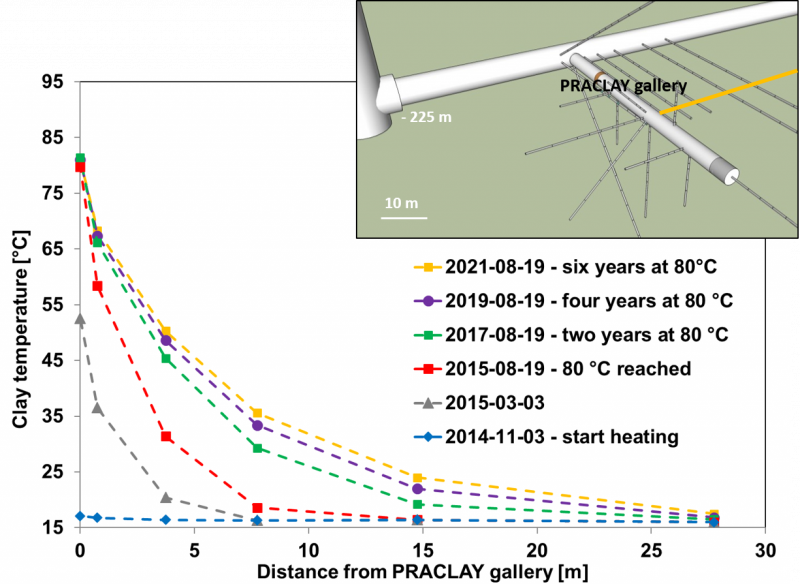Seven years of successful heating at the HADES URL

Seven years ago, on 3 November 2014, EIG EURIDICE switched on the heating system of the PRACLAY heating experiment. The goal of this experiment is to study the impact of heat, generated by high-level radioactive waste, on the Boom Clay formation. As the Boom Clay formation is considered a potential host rock for geological disposal, the PRACLAY heating experiment plays a key role in ONDRAF/NIRAS's research programme into the safety and feasibility of geological disposal of heat-producing high-level waste. It is difficult to overestimate the importance and outcome of this heating experiment. All the results already obtained confirm that the favourable properties of the clay for geological disposal are preserved when heated, enabling scientists to make a reliable and accurate prediction of the thermally induced changes around a real repository. The results and findings are now being published in international scientific journals.
After switching on the heating system, it took about nine months, until 19 August 2015, to reach the target temperature of 80°C at the interface between the clay and the concrete lining of the PRACLAY gallery. This was the official start of the 10-year heating phase. Observations and numerical models show that the experimental set-up is still functioning perfectly and is particularly robust. The heating system with its control and visualisation systems remains fully operational and the seal structure, closing off the heated, pressurised part of the gallery, is working as planned. There are clear indications that the concrete gallery lining of the heated part of the PRACLAY gallery has remained stable. Measurements and observations in the clay confirm and substantiate our current knowledge about its behaviour. They show that the favourable properties of the clay to confine high-level radioactive waste are retained when heated.
Refine knowledge
The extensive network of measuring instruments in and around the PRACLAY gallery continues to allow us to follow the evolution of the various parameters. The chart below represents the evolution of temperature since the switch-on of the heating system on 3 November 2014. The temperature measurements shown are from several horizontal boreholes that run parallel to the PRACLAY gallery. The temperature measurements confirm the existing numerical models and enable us to refine the model parameter values.

Figure - The points on the dashed lines show the temperature (T) of the clay as a function of the distance from the gallery, measured in several boreholes that run parallel to the PRACLAY gallery (at the position of the yellow line on the chart). At the start, the natural temperature of the clay was 17°C (blue curve). On 19 August 2015, the target temperature of 80°C where the gallery meets the clay was reached (red curve). Since then, the temperature where it meets the clay has been kept constant. In the clay, further away from the gallery, the temperature continues to rise with time. The yellow curve represents the situation at the end of August 2021.
In the remaining years of the experiment, the heat will spread further through the clay and temperature changes will also be observed at a greater distance from the heated gallery. Our scientists will incorporate this detailed information into the model calculations, enabling them to refine their knowledge of the behaviour of the clay. While final conclusions will be drawn when the experiment is over (in 2025), all interim results point to positive conclusions in terms of the main objective of the experiment: the heat impact on the clay is not affecting its favourable properties as a potential host rock for geological disposal of high-level radioactive waste.
Publications
All the scientific results and findings of the PRACLAY heating experiment are based on direct observations and measurements, and on the use of numerical models to interpret these observations and measurements. In this way, our scientists can confirm and further refine their knowledge of the properties and behaviour of the Boom Clay. Their work recently resulted in three scientific publications in international journals. One paper focuses on the observations of the thermo-hydro-mechanical behaviour of the Boom Clay, a second on the mathematical modelling of the PRACLAY heating experiment, while the third deals specifically with the thermal characterisation of the Boom Clay based on the integrated and comprehensive numerical work of the small-scale ATLAS heating tests and the large-scale PRACLAY heating experiment. The publication references can be found below.
- Dizier A., Chen, G., Verstricht J., Li X.L., Sillen X., Levasseur S., The large-scale in situ PRACLAY Heater test: First observations on the in situ thermo-hydro-mechanical behaviour of Boom Clay. International Journal of Rock Mechanics and Mining Sciences. Volume 137, January 2021. Link
- Chen G., Dizier A., Li X.L., Verstricht J., Sillen X., Levasseur S., 2021. Numerical prediction of the large-scale in situ PRACLAY Heater test in the Boom Clay. Rock Mechanics and Rock Engineering, 54(5), 2197-2218. Link
- Chen et al. Thermal characterization of the Boom Clay based on numerical interpretation of both a small-scale and a large-scale heater test. Acta Geotechnica (submitted)
